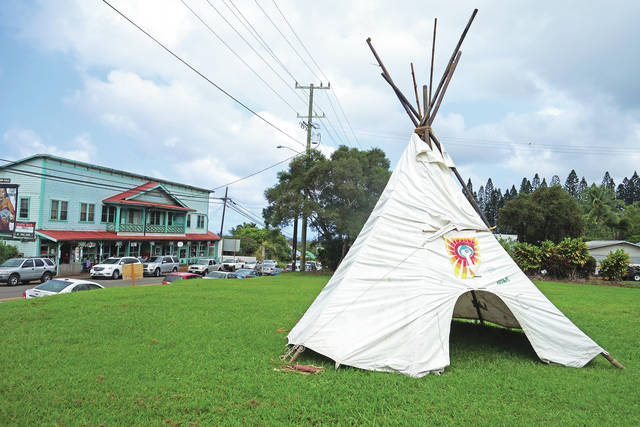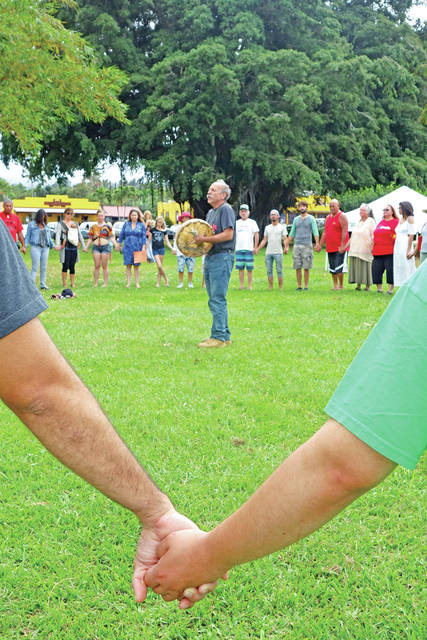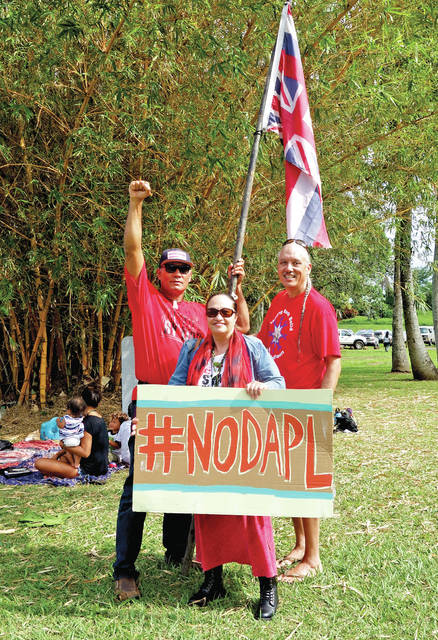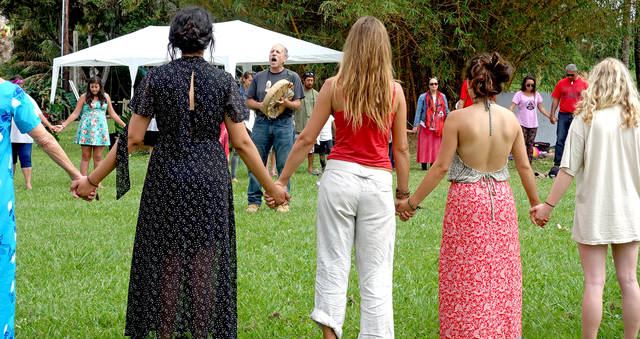Standing tall for Standing Rock: Kohala residents and visitors gather as part of global call to action
HAWI — Last Friday, indigenous people from across the U.S. marched on Washington, D.C. to demand that their lands and their rights be honored. In support of this far away effort, there was a simultaneous gathering in Hawi Park that included cultural practitioners and local and state community leaders to “Defend the Sacred.”
The event was organized by a newly formed group, Rally for Common Ground, which evolved out of the Kona Women’s March in January.
“It’s a small group but we felt strongly that we wanted to carry that work forward, and do an action in response to the global call to action from the leaders of the Standing Rock Sioux who are marching on Washington to protect Mother Earth,” said Maya Parish, one of two event organizers.
At 2:30 p.m., sign wavers stood along the highway backed by the steady throb of tribal drums, while the Coco Phresh team sliced open coconuts to provide fresh water.
The afternoon was all about connections and the hope that through those connections communities can continue to foster healthy environments on into the future.
“Water is life,” said Michal Anna Carrillo from Lava Roots Performing Arts, who just returned from Guinea where she’s been working to help provide clean water.
Organized in a very short time, the gathering was a Hawaiian style hui of community members from near and far who contributed their time and efforts to the event.
Kohala Coffee Mill, Kava Kafe and Sushi Rock made donations to the event’s fundraising recipients, Ohua O Na Kia’i No Na Keiki O Ka Aina — Lo’i Restoration and Honor the Earth, an organization to support the efforts of indigenous people.
At 3 p.m., participants assembled on the grass for an opening prayer and ceremony provided by Pua Case and Kalani Flores. Just back from Aotearoa, New Zealand, she brought a message of support from the far corner of the Polynesian triangle.
“We rise for another day because we know that we are supported. Let us be respectful, gracious. But our aloha does not mean we are weak. Instead it means we are a mighty force. This is how we can do something. We can keep gathering,” said Case.
Lisa Colombe, from the Rosebud Sioux tribe, brought the canvas from the welcome tepee she occupied at Standing Rock and worked with event participants to resurrect it.
“I was an environmental studies teacher and had a call to action. So I quit my job, grabbed my kids and moved from the city and took this tepee that’s here today up to Standing Rock. It was really interesting to me that a lot of my students from North Dakota and South Dakota were there, and it was very empowering to see young people rise up and demand better for themselves and their community,” she said.
Living here since December, Colombe offered a “great big mahalo from my heart” and a prayer to the crowd.
“It’s the shortest Lakota prayer. It’s what you offer when you go into the sweat lodge, when you leave, when you go into a tepee. And that’s mitakuye oyasin, that’s all my relatives. We are all connected. Every time you all pray (in Hawaiian) it’s like all these words are Lakota. You’re speaking my language,” she said.
Other speakers followed, interspersed with performances by hula halau Na Kupuna O Kohala and Hula Halau O Kukui Aloha O Kohala, and musicians Tiana & Off The Grid, Ka’ahele and Hualalai.
Lanakila Mangauil, representing the Honokaa Cultural Center, provided a booth. Just returned from a prayer run around Mount Fuji in Japan and carrying the Lono staff, he spoke of the need for awareness.
“When you learn and take that time to deepen your knowledge, then you will be able act upon what is pono. Your naau (heart, mind) comes into the light,” he said.
Sustainable Kohala was represented by Deborah Winter, who provided an informational booth and spoke about the work they do to support the re-establishment of food and water independence in Kohala.
“Thankfully, in the not-too-distant past, North Kohala was self-sufficient; residents relied upon what they could cultivate, hunt or make,” she said.
Hawaii Democratic Party was represented by former District 9 Councilmember Margaret Wille and Tim Vanderveer, the current party head, who flew over from Honolulu for the event.
Wille, who worked on Hawaii Island’s “Zero Waste” project and is now working with the state democratic committee, shared, “We have a lot to do here. We have lots of opportunities.”
Vanderveer spoke of gratitude and change.
“Today is very important because, as brother Lanakila said, you have to educate yourself. Bring the naau into the light. Organize and mobilize. Thanks to you people from the Big Island who voted for me to take back political power in our state for environmental justice, for social justice, for racial justice and to start to do things to change our party to reflect our values,” he said.
It is through connections that the island can speak truth to power.
“It’s the election that brought it out in me. I wanted to direct energy to something local,” said Parish. “There’s a lot we can do within our community, County Council and state Legislature to stand up for our values and beliefs in clean air and clean water for the future.”
Quoting Martin Luther King, Vanderveer concluded, “We may have come here on different ships, but we’re in the same boat now. Dr. King understood that that boat was economic injustice and poverty. That’s what it stems from — against indigenous people, against the environment. There’s no way we can have real justice unless we can solve that problem.”






